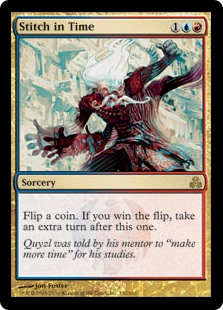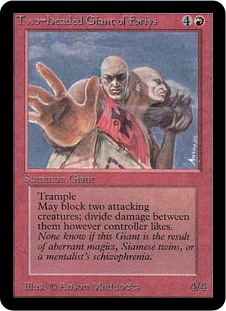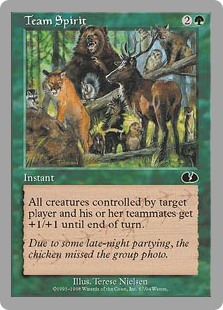Two headed giant is a variant of magic where players form teams of two and share both each turn and a life total with their teammate. The variant can be applied to constructed, limited, and other casual formats like Planechase or Commander. It’s often played at things like Prereleases, mainly because it’s a fun format where you NEED a partner! So your players will need to grab a friend to play!
How is it played?
Teammates are seated on the same side of the table. The player seated on the right of each team is considered the primary player. For constructed and limited formats, teams start the game at 30 life, instead of 20- remember that anything that affects a single player’s life total affects the team’s life total.
Teams move through the phases together and take their turns together. Players may share information openly with teammates, including any hidden information that they have access to. For example, after casting and resolving Peek on an opponent, a player may share the revealed hand to his or her teammate.
A team may declare attackers against their opponent as a team, and they’ll block as a team as well. Creatures with a landwalk ability are considered unblockable if either player controls one of those lands, and there are several other abilities like this that effect attacking and blocking and will affect both players, so ensure that your players are aware of these.
Whenever a combat damage step begins, any creatures that would be dealing damage to a player assign their damage to either player- the attacking player who controls the creature gets to decide which opponent to damage. (This matters sometimes, for example if a player has a Story Circle, the attacking player can damage the other defending player with attackers.)
The game is over under the normal win-loss conditions. If a team’s life-total ever reaches 0, a player goes to draw a card when there are zero cards left in their library, or if a team receives fifteen poison counters (15 because it takes more to kill 2 headed giants, obviously!), that team loses the game. Any other cards that give additional win or loss conditions, like Door to Nothingness, also apply as normal. If one player loses, the whole team loses.
Since these games tend to go on longer than normal one-versus-one games, matches are a first to win one game, instead of the normal best two out of three. In cases that the time limit is met, the game will continue with three additional turns instead of five when time is called.
 Since these games tend to go on longer than normal one-versus-one games, matches are a first to one win matches, instead of the normal best two out of three. In cases that the time limit is met, the game will continue with three additional turns instead of five when time is called.
Since these games tend to go on longer than normal one-versus-one games, matches are a first to one win matches, instead of the normal best two out of three. In cases that the time limit is met, the game will continue with three additional turns instead of five when time is called.
How does X card work?
- Cards referring to ‘you’ only apply to you, not your teammate.
- Cards with “at the beginning of /x/ step/phase” such as Curse of Chains trigger once.
- However, cards with “at the beginning of each player’s upkeep” like Havoc Festival will trigger twice.
- In the case of Havoc Festival, the team’s life total will be halved (rounded up) and then halved again. Cards that state each opponent like Palace Siege will affect each individual player. Other generic card questions are answered in the Two Headed Giant FAQ.
What limits are there on deck construction in Constructed? In Limited?
In Constructed, the normal guidelines for the format are followed with one additional rule. The four card copy limit of any nonbasic lands applies to both decks- this means that if one player chooses to play four copies of Lightning Bolt, his or her teammate can’t have a single of copy of Lightning Bolt in his or her deck. Alternately, both players have to split a max of 4 Lightning Bolts between the two decks.
In Limited, the team builds two forty card minimum decks from their collective card pool. In sealed, the team receives a collective eight boosters for the team, instead of six boosters per person. (Note- At prereleases, often a team will open 2 Prerelease box kits, for a total of 12 boosters. This is completely ok for a fun experience!)
For limited, sideboarding is allowed only after a draw happens.
For constructed, sideboards aren’t allowed at all so wish cards don’t work at all.
What about the new Mulligan (the Vancouver Mulligan)? How does it work in 2HG?
The new mulligan lets you scry 1, but only if you have less than your starting hand size after mulligans in a game. So, because you get a free mulligan (back to the same number of cards) in 2HG, you don’t get to scry unless you take multiple mulligans.
More information on that here.
For further reference
Find the most up to date info at the Two Headed Giant Release Notes Project:
http://blogs.magicjudges.org/2hg/
The Two Headed Giant FAQ –http://wpn.wizards.com/sites/wpn/files/attachements/magic_the_gathering_twoheaded_giant_tournament_faq_pdf1.pdf
Slightly outdated at this point, please see the blogs above for more up to date info.
Section 9, “Two Headed Giant Tournament Rules” of the Magic Tournament Rules. – http://wpn.wizards.com/sites/wpn/files/attachements/mtg_mtr_17jul15_en_0.pdf
Sections 805 and 810 in the Comprehensive Rules. – http://magic.wizards.com/en/gameinfo/gameplay/formats/comprehensiverules


